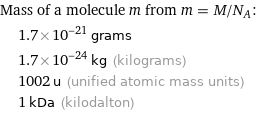Input interpretation

barium sodium niobium oxide | molar mass
Result

Find the molar mass, M, for barium sodium niobium oxide: M = sum _iN_im_i Plan: • Write the chemical formula and gather atomic masses from the periodic table. • Determine values for N_i and m_i using these items. • Finally, compute the mass. Write the chemical formula: Ba_2NaNb_5O_15 Use the chemical formula to count the number of atoms, N_i, for each element: | N_i Ba (barium) | 2 Na (sodium) | 1 Nb (niobium) | 5 O (oxygen) | 15 Look up the atomic mass, m_i, in g·mol^(-1) for each element in the periodic table: | N_i | m_i/g·mol^(-1) Ba (barium) | 2 | 137.327 Na (sodium) | 1 | 22.98976928 Nb (niobium) | 5 | 92.90637 O (oxygen) | 15 | 15.999 Multiply N_i by m_i to compute the mass for each element. Then sum those values to compute the molar mass, M: Answer: | | | N_i | m_i/g·mol^(-1) | mass/g·mol^(-1) Ba (barium) | 2 | 137.327 | 2 × 137.327 = 274.654 Na (sodium) | 1 | 22.98976928 | 1 × 22.98976928 = 22.98976928 Nb (niobium) | 5 | 92.90637 | 5 × 92.90637 = 464.53185 O (oxygen) | 15 | 15.999 | 15 × 15.999 = 239.985 M = 274.654 g/mol + 22.98976928 g/mol + 464.53185 g/mol + 239.985 g/mol = 1002.161 g/mol
Unit conversion

1.00216 kg/mol (kilograms per mole)
Comparisons

≈ 1.4 × molar mass of fullerene ( ≈ 721 g/mol )

≈ 5.2 × molar mass of caffeine ( ≈ 194 g/mol )

≈ 17 × molar mass of sodium chloride ( ≈ 58 g/mol )
Corresponding quantities

Mass of a molecule m from m = M/N_A: | 1.7×10^-21 grams | 1.7×10^-24 kg (kilograms) | 1002 u (unified atomic mass units) | 1 kDa (kilodalton)

Relative molecular mass M_r from M_r = M_u/M: | 1002